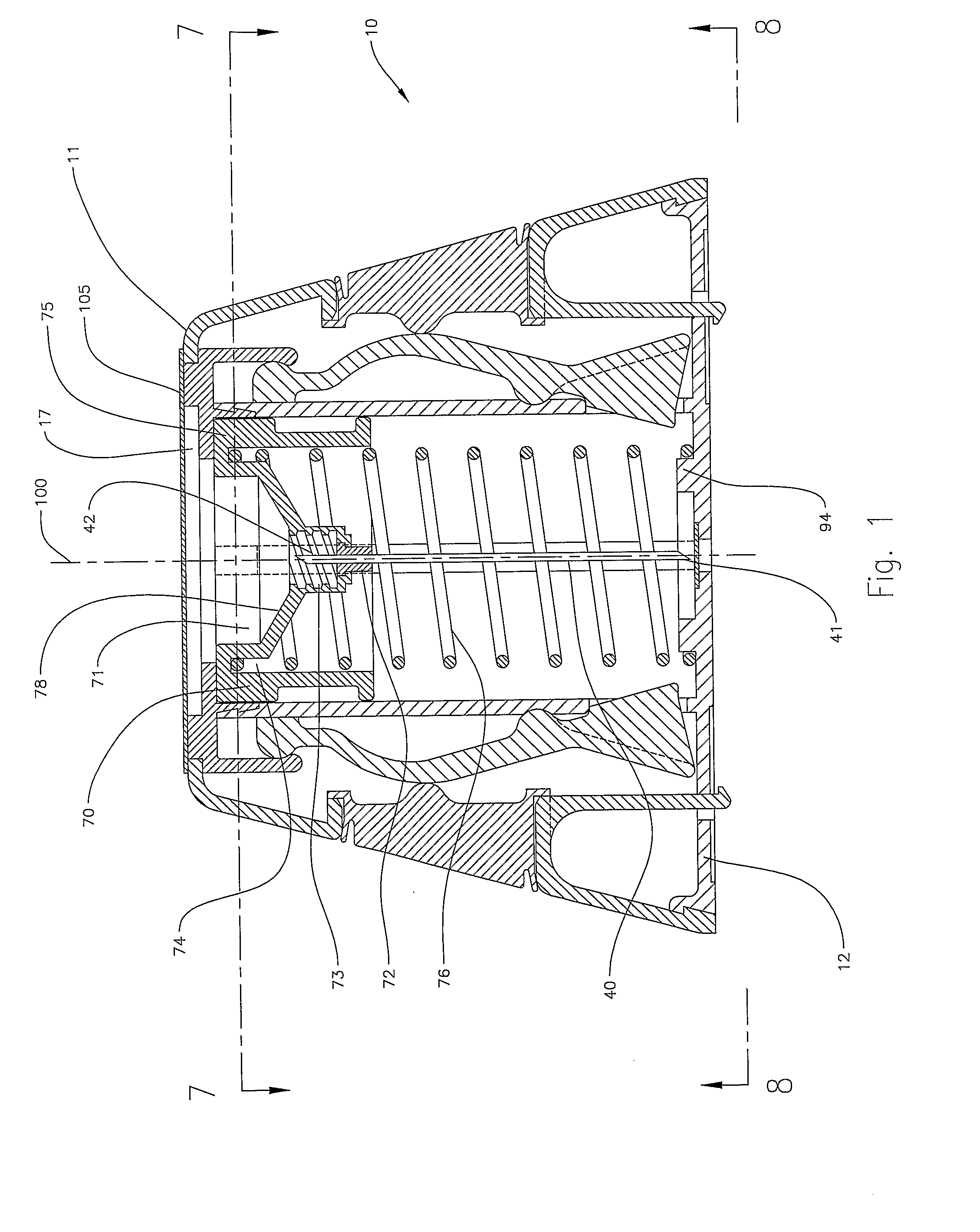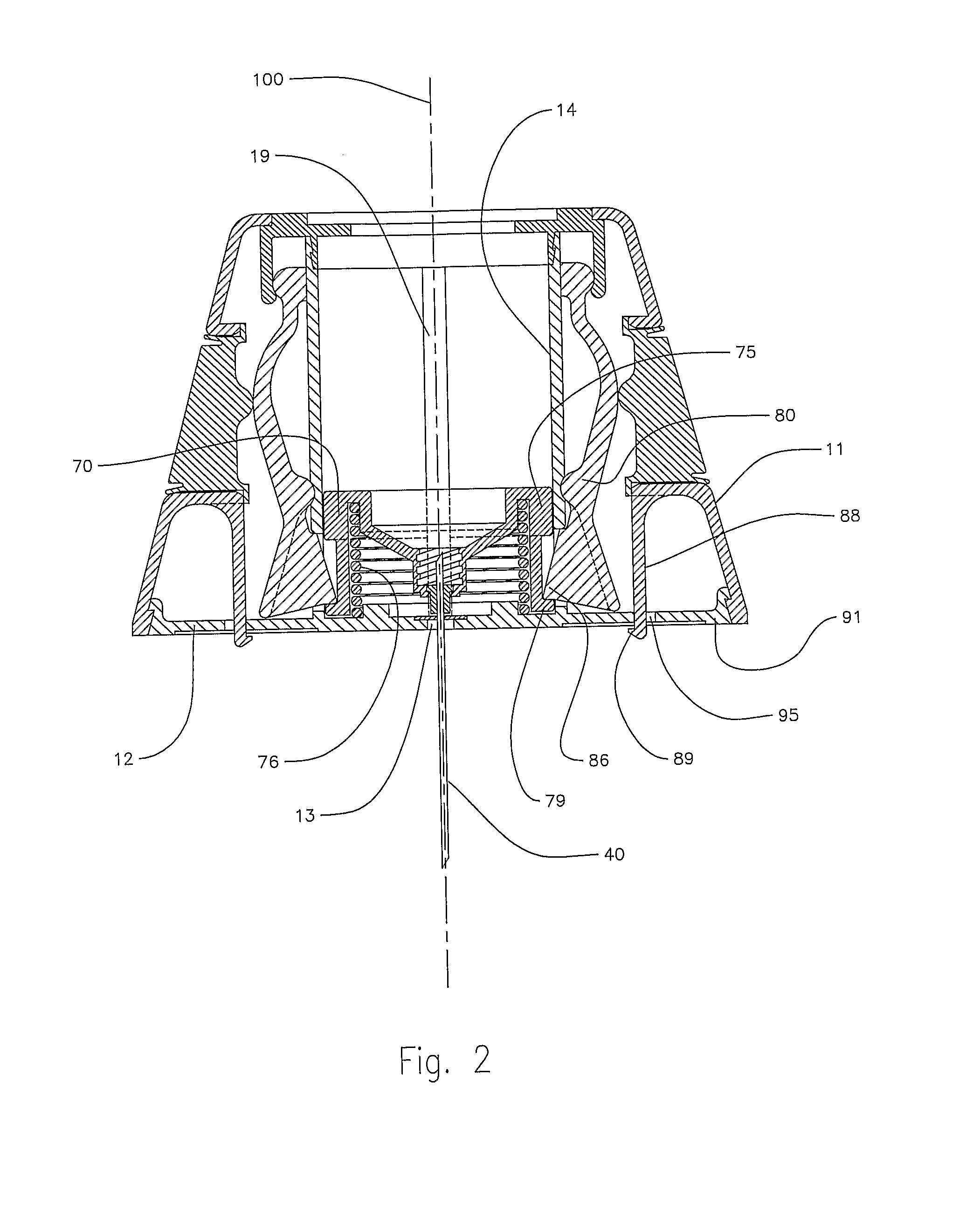Injection Device for Administering a Vaccine
- Summary
- Abstract
- Description
- Claims
- Application Information
AI Technical Summary
Benefits of technology
Problems solved by technology
Method used
Image
Examples
first embodiment
[0093] the invention is shown in FIGS. 1-3, 3A, and 4-28. The device includes a housing, shown in FIGS. 1-3, 3A, and 4-9, and a cylindrical syringe cartridge shown in FIGS. 10-19. The use and operation of the device for manually self-administering a painless injection is illustrated in FIGS. 20-28. A device having a housing for retaining a plurality of cylindrical syringe cartridges is shown in FIGS. 29-31. FIGS. 32-25 show a separable base and means for attaching the device to a patient's skin.
[0094]FIGS. 1-8 show an assembled housing 10 in various views and aspects. FIG. 1 shows the housing 10 having an outer body 11, a needle carriage 70, a means for retaining a reservoir for an injectable liquid composition, and a base 12 for placement of the device against the skin of a patient. The carriage 70 is configured for movement along an axial centerline 100 in a direction perpendicular to the base 12. The cylindrical carriage has a cylindrical recess 71 having a tapered bottom 78, tha...
second embodiment
[0128] In the present invention, the device employing a separable base 92 can comprise a device that comprises an on-board power means, as described above, for inserting the injection needle, and optionally, injecting the medication and retracting the needle. As shown in FIG. 19, and referring to FIG. 11, the syringe cavity can comprise a self-contained power source in the form of the compressed pressurizing spring 33. In the illustrated embodiment, the compressed spring is exerting its force upon the vaccine contained in the cavity 66, placing it under pressure. Optionally, in this alternative embodiment, the cylindrical body 31 can be configured with a retainer pin that withholds the pressurizing spring 33 (and therefore pressure upon the vaccine) from contact with the plunger 24, or withholds the plunger 24 itself, until released by a releasing means, such as an annular retaining ring having a tab extending through the cylinder wall 31.
third embodiment
[0129] In the present invention, a device can have a plurality of injection needles and reservoirs disposed within the housing. The device can provide for injecting at least two injectable liquid compositions to a patient. FIGS. 29 and 30 show a top plan view and an elevation view of a device 1 for injecting at least two liquid compositions from separate reservoirs contained in the housing. As shown in FIG. 31, the device 1 can comprise a housing 10 and base 12 for two needle carriages 70a and 70b and two injection needles 40a and 40b, which can be configured to be separately and independently manipulated for insertion, injection and retraction, as described herein above.
[0130] Alternatively, the two needle carriages and needles can be configured for simultaneous insertion, injection, and retraction using shared elements, including a shared, dual-recess needle carriage, and a dual unitary pressurizing assembly.
[0131] If only one injectable liquid composition will be administered, t...
PUM
 Login to View More
Login to View More Abstract
Description
Claims
Application Information
 Login to View More
Login to View More - R&D
- Intellectual Property
- Life Sciences
- Materials
- Tech Scout
- Unparalleled Data Quality
- Higher Quality Content
- 60% Fewer Hallucinations
Browse by: Latest US Patents, China's latest patents, Technical Efficacy Thesaurus, Application Domain, Technology Topic, Popular Technical Reports.
© 2025 PatSnap. All rights reserved.Legal|Privacy policy|Modern Slavery Act Transparency Statement|Sitemap|About US| Contact US: help@patsnap.com



